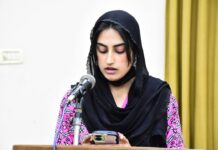ISLAMABAD: Over the past two decades, Pakistan has produced a relatively vibrant media sector that represents a diversity of political views and opinions. However, in recent years, subsequent governments and other influential powers have curtailed media freedom in ways that threaten pluralism and journalistic independence in the country. This has been done by drawing new “red lines” against unpalatable issues.
Late journalist Arshad Sharif, who had been a hard-core critic of those responsible of ‘Regime Change’ fled Pakistan in August due to sedition charges leveled against him for allegedly criticizing state institutions and “abetting mutiny” within the military.
Sharif had to “flee Pakistan in August to save his life,” a close associate of his revealed. He had initially gone to Dubai but was forced to flee from the UAE due to “harassment by Pakistani officials,” the associate added.
Sharif had “only been in Kenya for a few weeks since that is one of the few places Pakistani passport holders don’t need a visa for entry,” the associate said, while adding that the mysterious circumstances under which Sharif had been brutally murdered must be investigated.
The Human Rights Commission of Pakistan tweeted on Monday that “a long, grim record of violent tactics to silence journalists explain why the reported murder of journalist Arshad Sharif in Kenya has sent shock waves through the journalist community.”
However, Sharif is not the first one, and considering the on-going trend of silencing the voice of Pakistani journalists who question, he certainly won’t be the last one. Pakistan has a history of media suppression and violence against journalists.
Reportedly, 118 journalists have been killed in Pakistan since year 2000.
In February 2020, journalist Aziz Memon was murdered in Mehrabpur, Sindh. Shortly before he was killed, he released a video statement in which he allegedly claimed that the “SSP Nowshero Feroz and local political supporters have made his life hell, and that his kids have been receiving threats repeatedly”
In 2011, journalist Saleem Shehzad was found dead, 4 days after his story on PNS Mehran attack surfaced in which he claimed that Al-Qaeda had allegedly penetrated inside Pakistan Navy.
Journalist Javed Chaudhry revealed that “before Saleem Shehzad’s death, he had allegedly told his family that if he gets abducted or harmed, then ISI would be responsible for it”
It is pertinent to note that most of these killings are linked with reporting on hardcore issues. In 2011, journalist Wali Khan Babar was shot dead for his reporting on crimes in Karachi.
Reportedly, many people linked to the investigation were also executed. Journalist Hamid Mir later revealed that “his killing was ordered from South Africa, and all accused were associated with Mutahhida Qaumi Movement (MQM)”
Unfortunately, in many cases, killers of journalists have impunity.
In 2014, journalist Hamid Mir got critically injured in an assassination attempt. After the assassination attempt, his brother, Amir Mir, who is also a journalist, revealed that “it happened because of Hamid Mir’s criticism of political involvement of intelligence agencies”
The same year, in 2014, journalist Raza Rumi narrowly escaped a murder attempt. According to reports, he was allegedly attacked by militants for his criticism on blasphemy law.
In 2017, journalist Ahmed Noorani was also assaulted by baton and knives.
In 2010, journalist Umar Cheema was abducted and tortured for his investigative reporting. Talking about his abduction, he claimed that “the pattern that was exercises, the history and everything else suggested that such operations are conducted in such a manner by the intelligence agencies in Pakistan”
Families of journalists also remain vulnerable to threats.
Journalist Hamid Mir in 2016 revealed that “he has sent his kids to abroad because their car was attacked by unknown people while going to the school”, while adding that “he registered a case to the police and they said, you know who they are, we can’t help you”
Media houses also complain that journalists self-censor themselves.
Najam Sethi in 2019 stated that “every time we ask a question, our credentials are challenged. We are accused of being treasonable and then efforts are afoot to gag us”
A report revealed that over the course of one year – between May 2021 and April 2022, at least 86 cases of attacks and violations against media and its practitioners, including journalists, took place in Pakistan.
While the overall number of documented violations in the preceding year has gone down several notches, there is a continuing trend of targeting journalists working for digital media, according to a research and analysis report by the Freedom Network, an award-winning Pakistan-based media rights watchdog that tracks violations against journalists and attacks on freedom of expression on an ongoing basis.
The report revealed that the state actors continue to be the largest threat source for journalists in Pakistan in a period marked by a dramatic escalation of coercion by the erstwhile Imran Khan government resulting in murders, legal cases, assaults, abductions, detentions and threats.
“As the digital media landscape is the new horizon over Pakistan, the government is more than anxious to crack down on online freedom and digital journalists are systematic target of harassment, abuses and legal threats. We must protect our borderless Internet freedom,” Iqbal Khattak, the Executive Director of Freedom Network, said.
The data shows that no place in the four Pakistani provinces, federal capital Islamabad or even Gilgit-Baltistan and Azad Jammu and Kashmir is safe – attacks against journalists are taking place everywhere.
The top three categories of violations against the journalists in Pakistan in the period under review included (a) 13 legal cases filed against them (15%) and 13 cases of offline harassment (15%), (b) 11 instances of illegal detention by the authorities (13%), and (C) nine cases of attempt to murder (11%) and nine cases of verbal threats (11%).
“These six categories of violations – legal cases, offline harassment, illegal detention, attempt to murder and verbal threats – constituted 65% of the 83 categories of violations against media in Pakistan in the period,” it added.
Most dangerous regions for journalists
Overall, Islamabad emerged as the riskiest and most dangerous place to practice journalism in Pakistan with 37% of the violations (32 out of total 86 cases) recorded in the federal capital.
Sindh was the second-worst with 27% of the violations (23 cases) and Khyber-Pakhtunkhwa (K-P) the third most dangerous with 19% (16 cases).
These were followed by Punjab with 13% (11 cases), Balochistan with about 2% (two cases) and one case each from AJK and GB.
TV and print media in crosshairs
Of the total 86 attacks and violations against journalists recorded in Pakistan in the period under review, TV medium emerged as the single largest victim of the type of media with at least 39 cases (45%) of the cases against its practitioners compared to print, radio and internet.
Print media was the second most targeted medium with 35 journalists working for it targeted (41%) while 12 cases (14%) were recorded of online journalists targeted. No targeting of a radio journalist was documented.
Biggest threat
In a whopping 41% of the 86 documented cases (at least 35 cases) of violations against media practitioners in Pakistan – thus the biggest threat actor – in the period under review, the victims or their families suspect the involvement of the state and its authorities and functionaries in the attacks on them compared to other influential threat actors.
A group of miscellaneous ‘others’ with 24% (at least 21 cases) emerged as the second-largest threat actor in the period under review. The victims and their families, as well as the authorities and their employers, have been unable to identify perpetrators of violations against 22 journalists (25% cases).
Surprisingly another category of threat actors identified by the victims, or their families, were political parties – constituting 4% (3 cases).
Targeting women media practitioners
In at least three of the total 86 violations against media practitioners in the period under review the targets were women journalists receiving threats of dire consequences or harassment.
Digital media journalists in the crosshairs
In at least 12 of the total 86 violations (or 14%) against media practitioners in the period under review, the targets were journalists working with digital media. These included two of the four journalists killed.
Despite protests, the threats of losing their lives and the fear of censorship continue to haunt journalists.






















